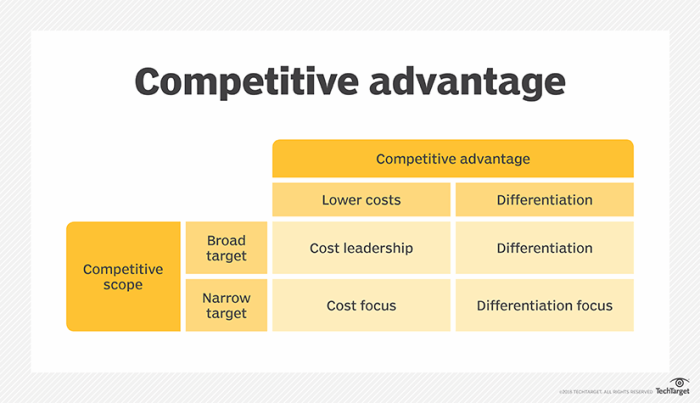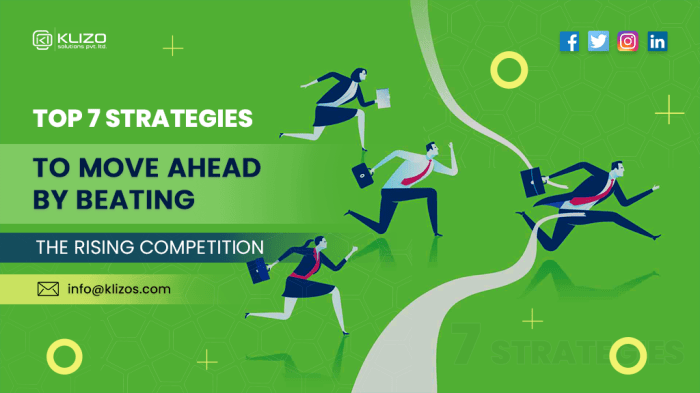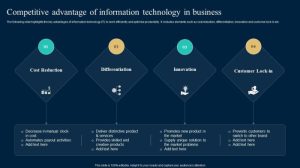
Securing a competitive edge in today’s dynamic marketplace requires a multifaceted approach. This exploration delves into the crucial elements of building a sustainable competitive advantage, from meticulous market analysis and the crafting of a compelling value proposition to operational excellence and strategic partnerships. We will examine how businesses can leverage innovation, technology, and efficient strategies to not only compete but thrive.
Understanding the nuances of cost leadership, differentiation, and niche market strategies is paramount. This guide provides a practical framework for identifying opportunities, analyzing competitors, and ultimately, establishing a position of strength and resilience within your chosen market. We’ll explore real-world examples of successful strategies and analyze the pitfalls of those that failed, providing actionable insights for your own business endeavors.
Defining Competitive Advantage
A competitive advantage represents a firm’s ability to outperform its rivals, creating and sustaining superior profitability. It’s not simply about being better; it’s about consistently delivering greater value to customers in a way that competitors cannot easily replicate. This translates to higher profits, market share, and long-term success. Achieving a sustainable competitive advantage requires a strategic approach, careful analysis of the market, and a deep understanding of the firm’s capabilities.
Core Components of a Sustainable Competitive Advantage
A truly sustainable competitive advantage rests on several key pillars. These elements work in concert to create a barrier to entry for competitors and ensure long-term success. A lack in any one area can significantly weaken the overall advantage.
- Value Creation: The ability to offer products or services that customers perceive as superior in terms of quality, features, or price. This superior value proposition attracts and retains customers.
- Rarity: Possessing resources or capabilities that are unique and not readily available to competitors. This could be intellectual property, specialized skills, or access to exclusive resources.
- Inimitability: The difficulty for competitors to copy or replicate the firm’s value creation activities. This might stem from complex processes, strong brand loyalty, or proprietary technology.
- Non-substitutability: The absence of readily available substitutes that offer comparable value to customers. This protects the firm from competition from alternative offerings.
- Organization: The firm’s internal structure, processes, and culture must be aligned to effectively leverage its resources and capabilities to create and sustain the competitive advantage. This includes effective management and efficient operations.
Examples of Companies with Strong Competitive Advantages
Several companies illustrate the principles of sustainable competitive advantage.
- Apple: Apple’s competitive advantage stems from a combination of factors: a strong brand, a seamless ecosystem of hardware and software, and a focus on design and user experience. These elements are difficult for competitors to replicate, creating high customer loyalty and premium pricing power.
- Amazon: Amazon’s dominance in e-commerce is rooted in its vast logistics network, efficient operations, and a powerful recommendation engine. Its scale and technological prowess create a significant barrier to entry for competitors.
- Coca-Cola: Coca-Cola’s iconic brand recognition and global distribution network are key components of its enduring competitive advantage. Its brand loyalty is exceptionally strong, making it difficult for competitors to gain market share.
Comparison of Competitive Advantage Types
Firms can pursue different strategies to achieve competitive advantage. Three common approaches are:
| Competitive Advantage Type | Description | Example |
|---|---|---|
| Cost Leadership | Offering products or services at the lowest price in the market while maintaining acceptable quality. | Walmart |
| Differentiation | Offering unique products or services that are perceived as superior and command a premium price. | Apple |
| Niche Market | Focusing on a specific segment of the market with specialized needs and offering tailored products or services. | Ferrari |
Framework for Identifying Potential Competitive Advantages
Identifying potential competitive advantages requires a systematic approach. A framework might include:
- Industry Analysis: Analyze the industry structure, competitive landscape, and key success factors.
- Resource Assessment: Identify the firm’s internal resources and capabilities, including tangible and intangible assets.
- Value Chain Analysis: Analyze the firm’s value chain to identify activities where it can create superior value or achieve cost efficiencies.
- Competitive Benchmarking: Compare the firm’s performance against its competitors to identify areas of strength and weakness.
- SWOT Analysis: Conduct a SWOT analysis to synthesize the findings from the previous steps and identify potential competitive advantages.
Value Proposition & Differentiation
A compelling value proposition and effective differentiation are crucial for gaining a competitive advantage. They form the foundation of your marketing strategy, guiding your efforts to attract and retain customers in a crowded marketplace. Without a clear understanding of what makes your offering unique and valuable, your marketing will lack focus and impact.Developing a strong value proposition and differentiating your product or service requires a deep understanding of your target market, your competitors, and your own unique strengths.
This involves not just identifying what you offer, but also articulating why customers should choose you over the alternatives.
Crafting a Compelling Value Proposition
A value proposition succinctly communicates the unique benefits a customer receives by choosing your product or service. It should address a specific customer need or pain point and highlight how your offering provides a superior solution. Consider the following elements when crafting your value proposition: target audience, key benefits, competitive advantages, and a clear and concise message. For example, a premium coffee shop might position its value proposition around “experiencing the finest ethically sourced beans, expertly crafted, in a sophisticated and relaxing atmosphere.” This statement clearly targets a specific customer segment (those who appreciate quality and ambiance), highlights key benefits (high-quality coffee and pleasant environment), and differentiates itself from competitors (implying superior sourcing and preparation).
Strategies for Product/Service Differentiation
Effective differentiation involves highlighting aspects of your offering that set it apart from the competition. This could be based on various factors, including product features, quality, price, customer service, brand image, or distribution channels. Several strategies can be employed:
- Product Differentiation: This involves creating a product with unique features or superior performance compared to competitors. For instance, a car manufacturer might differentiate its vehicles through advanced safety features or innovative engine technology.
- Service Differentiation: Superior customer service, personalized attention, or convenient access can be powerful differentiators. A luxury hotel, for example, might differentiate itself through impeccable service and personalized concierge services.
- Price Differentiation: While often a less sustainable strategy, offering a significantly lower price can attract price-sensitive customers. However, this should be carefully considered to ensure profitability.
- Niche Differentiation: Focusing on a specific segment of the market with unique needs can allow for specialization and a strong competitive position. A company offering organic and sustainable clothing targets a specific environmentally conscious segment.
The Role of Branding in Competitive Advantage
Branding is more than just a logo; it’s the overall perception and experience associated with your product or service. A strong brand builds trust, loyalty, and recognition, creating a significant competitive advantage. A well-defined brand identity, consistent messaging, and positive customer experiences contribute to brand equity, making your offerings more desirable and less susceptible to price competition. For example, Apple’s brand is synonymous with innovation, design, and a premium user experience, allowing them to command higher prices than many competitors.
Designing a Marketing Campaign
Your marketing campaign should directly reflect your value proposition and differentiation strategy. It needs to clearly communicate the unique benefits your offering provides and highlight what sets you apart from the competition. This might involve:
- Targeted advertising: Focusing on specific customer segments through channels where they are most likely to engage.
- Content marketing: Creating valuable and engaging content that educates and informs potential customers about your product or service.
- Social media marketing: Building a strong online presence and engaging with potential customers on social media platforms.
- Public relations: Generating positive media coverage and building relationships with key influencers.
A successful marketing campaign will reinforce your brand message, highlight your unique value proposition, and ultimately drive sales and build market share.
Operational Excellence & Efficiency

Achieving operational excellence is paramount for gaining a sustainable competitive advantage. It involves streamlining processes, reducing waste, and maximizing resource utilization to deliver superior value at lower costs. This section explores key operational areas for improvement and strategies for leveraging technology to enhance efficiency.Operational excellence isn’t just about cost reduction; it’s about creating a more agile and responsive organization capable of adapting to market changes and exceeding customer expectations.
By focusing on efficiency, businesses can free up resources to invest in innovation, marketing, and other growth initiatives.
Key Operational Areas for Improvement
Improving operational efficiency requires a holistic approach, examining various aspects of the business. Identifying bottlenecks and areas with high waste is crucial for targeted improvements. This involves analyzing processes, workflows, and resource allocation to pinpoint areas needing optimization.
- Production Processes: Streamlining manufacturing processes to minimize waste (materials, time, energy) and maximize output. This might involve implementing lean manufacturing principles or adopting automation technologies.
- Supply Chain Management: Optimizing the flow of goods and services from origin to end consumer. This includes efficient inventory management, reliable transportation, and strong supplier relationships.
- Customer Service: Improving response times, resolving issues efficiently, and providing personalized service to enhance customer satisfaction and loyalty. This can involve implementing CRM systems and streamlining communication channels.
- Human Resources: Optimizing workforce productivity through effective training, performance management, and employee engagement strategies. This might include investing in employee development programs or implementing flexible work arrangements.
- Information Technology: Leveraging technology to automate tasks, improve data analysis, and enhance communication and collaboration across departments. This could involve implementing ERP systems or utilizing data analytics tools.
Lean Manufacturing Principles and Their Application
Lean manufacturing focuses on eliminating waste and maximizing value for the customer. Its principles, when effectively implemented, can significantly enhance operational efficiency and reduce costs. The core principles of lean manufacturing often include a focus on value stream mapping, identifying and eliminating waste (muda), and continuous improvement (kaizen).
- Value Stream Mapping: A visual representation of all steps in a process, identifying areas of waste and opportunities for improvement. By visualizing the entire process, bottlenecks and inefficiencies become readily apparent.
- Just-in-Time (JIT) Inventory: Minimizing inventory levels by receiving materials only when needed for production. This reduces storage costs and the risk of obsolescence.
- Kaizen (Continuous Improvement): A philosophy of ongoing improvement, encouraging employees to identify and suggest improvements to processes and workflows. This fosters a culture of innovation and efficiency.
- 5S Methodology: A workplace organization method focusing on sorting, setting in order, shining, standardizing, and sustaining. This creates a more efficient and safer work environment.
Optimizing Supply Chain Management and Logistics
Effective supply chain management is critical for operational excellence. Optimizing this area can significantly reduce costs, improve delivery times, and enhance customer satisfaction.
- Strategic Partnerships: Building strong relationships with reliable suppliers to ensure timely delivery of high-quality materials. This also includes negotiating favorable pricing and payment terms.
- Inventory Management: Implementing sophisticated inventory control systems to minimize storage costs, reduce waste, and ensure sufficient stock to meet demand. This might involve utilizing forecasting techniques and advanced inventory management software.
- Transportation Optimization: Choosing efficient and cost-effective transportation methods, including route optimization and efficient loading and unloading procedures. This might involve using route planning software or negotiating favorable rates with carriers.
- Warehouse Management: Optimizing warehouse layout and processes to streamline the movement of goods. This could include implementing automated storage and retrieval systems or improving picking and packing procedures.
Technology’s Role in Enhancing Operational Efficiency
Technology plays a crucial role in driving operational excellence. Investing in the right technologies can significantly improve efficiency and reduce costs.
- Enterprise Resource Planning (ERP) Systems: Integrate various business functions, providing a single source of truth for data and improving communication and collaboration across departments.
- Supply Chain Management (SCM) Software: Provides real-time visibility into the supply chain, enabling better planning, forecasting, and inventory management.
- Data Analytics: Analyzing operational data to identify trends, patterns, and areas for improvement. This allows for data-driven decision-making and continuous optimization.
- Automation Technologies: Automating repetitive tasks, reducing errors, and improving efficiency. This includes robotics, automated guided vehicles (AGVs), and other automation solutions.
Strategic Partnerships & Alliances

Strategic partnerships and alliances represent a powerful avenue for businesses to gain a competitive edge. By collaborating with other companies, businesses can leverage complementary resources, expand market reach, and access new technologies or expertise, ultimately enhancing their overall competitiveness. This synergistic approach often proves more effective than attempting to achieve these goals independently.Strategic partnerships offer numerous benefits that contribute significantly to a company’s competitive advantage.
These benefits extend beyond simple cost savings and encompass broader strategic goals.
Benefits of Strategic Partnerships
Collaborating with strategic partners provides access to new markets and customer segments that might be difficult or expensive to reach alone. For example, a small, innovative technology company might partner with a larger, established distributor to rapidly expand its market presence. Furthermore, partnerships can unlock access to specialized technologies, skills, or intellectual property, accelerating innovation and reducing development time and costs.
A pharmaceutical company might partner with a biotech firm to gain access to cutting-edge research and development capabilities, speeding up the drug development process. Finally, sharing resources and risks through partnerships allows companies to achieve economies of scale, improve operational efficiency, and increase profitability. A manufacturing company might partner with a logistics provider to streamline its supply chain, leading to reduced costs and improved delivery times.
Examples of Successful Strategic Partnerships
The success of strategic alliances is demonstrably linked to enhanced competitive advantage. Consider the partnership between Apple and IBM. This collaboration combined Apple’s design expertise and consumer-facing brand with IBM’s enterprise software and services. The result was a significant expansion of Apple’s reach into the enterprise market, creating a new competitive landscape. Another compelling example is the alliance between Starbucks and Barnes & Noble.
This partnership strategically positioned both brands in complementary spaces, driving traffic and increasing customer loyalty for both companies. The combined presence created a more attractive destination for customers seeking coffee and books, giving each partner a competitive advantage over standalone coffee shops and bookstores.
Identifying and Selecting Suitable Partners
Identifying and selecting suitable partners is a critical step in forming successful strategic alliances. A thorough due diligence process is crucial. This involves evaluating potential partners based on their strategic fit, financial stability, and operational capabilities. Compatibility of corporate cultures and management styles should also be considered to ensure a smooth and productive partnership. A robust assessment process, encompassing financial analysis, market research, and legal review, minimizes potential risks and maximizes the likelihood of success.
Framework for Evaluating Potential Benefits and Risks
A structured framework is essential for evaluating the potential benefits and risks associated with strategic partnerships. This framework should encompass several key areas:
- Strategic Alignment: Assessing the degree to which the partner’s goals and strategies align with the company’s own objectives.
- Financial Viability: Evaluating the partner’s financial health and stability to mitigate financial risks.
- Operational Capabilities: Assessing the partner’s operational efficiency and capacity to deliver on its commitments.
- Cultural Compatibility: Examining the compatibility of corporate cultures and management styles to avoid potential conflicts.
- Risk Assessment: Identifying and evaluating potential risks, such as legal, reputational, and operational risks, and developing mitigation strategies.
By carefully evaluating these factors and documenting the findings, companies can make informed decisions about potential partners, maximizing the chances of a successful and mutually beneficial alliance. A quantitative scoring system, applied to each criterion within the framework, can further enhance the decision-making process.
Successfully navigating the competitive landscape demands a proactive and adaptable approach. By strategically combining market analysis, value proposition development, operational efficiency, and innovative thinking, businesses can cultivate a sustainable competitive advantage. This involves not only understanding your own strengths and weaknesses but also those of your competitors, and constantly evolving to meet the changing demands of the market. The journey to lasting success requires a commitment to continuous improvement and a willingness to embrace new opportunities.
Essential FAQs
What is the difference between a competitive advantage and a sustainable competitive advantage?
A competitive advantage simply means you outperform competitors. A
-sustainable* competitive advantage means this outperformance is durable and difficult for rivals to replicate.
How important is branding in achieving a competitive advantage?
Branding is crucial. A strong brand builds trust, loyalty, and a perceived value that differentiates your offerings and commands premium pricing.
Can small businesses compete with larger corporations?
Absolutely. Small businesses often leverage agility, niche specialization, and personalized service to compete effectively against larger, less flexible competitors.
What role does technology play in gaining a competitive edge?
Technology can significantly enhance efficiency, streamline operations, create innovative products, and improve customer experience, providing a substantial competitive advantage.
How can I identify unmet customer needs?
Conduct thorough market research, analyze customer feedback, monitor social media conversations, and engage in direct customer interaction to uncover unmet needs.





